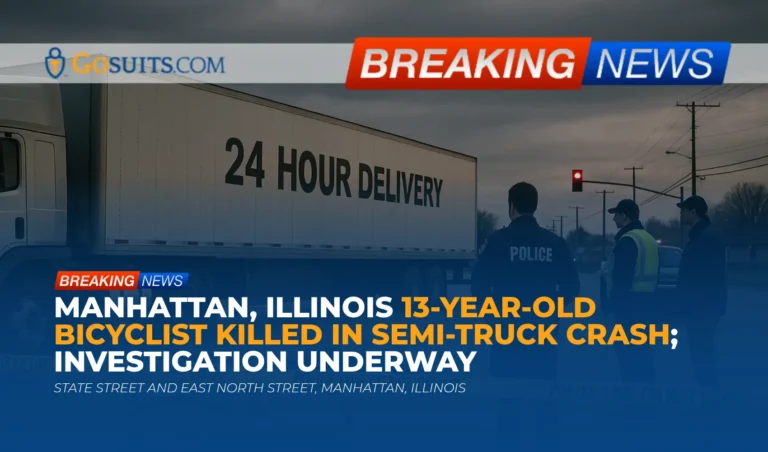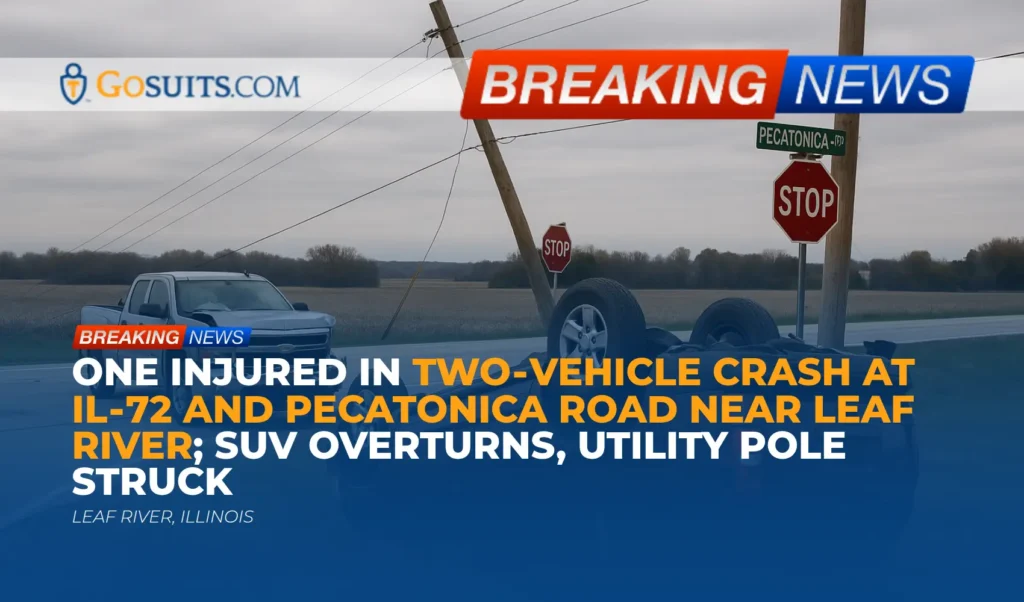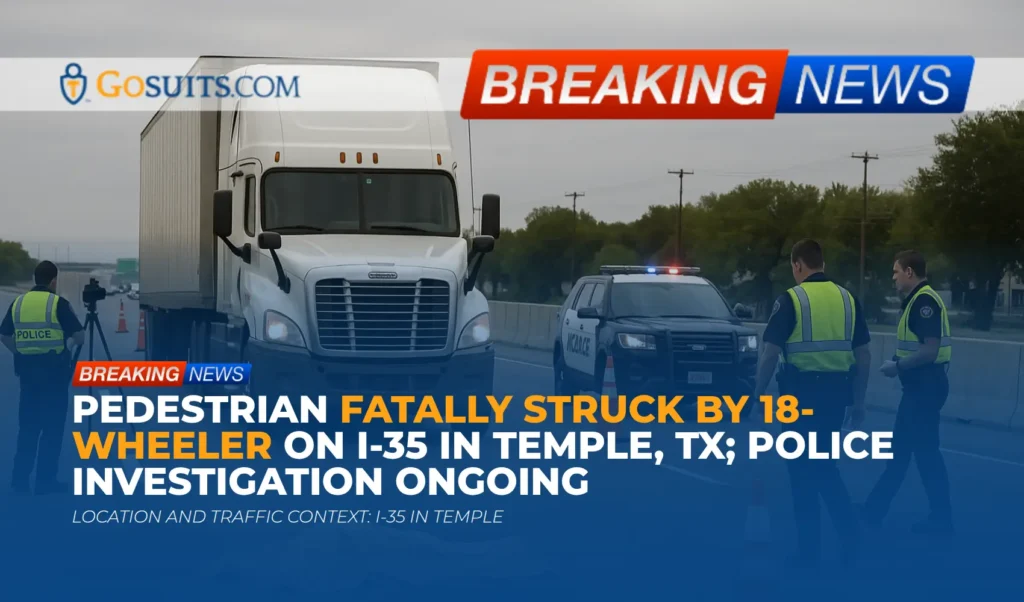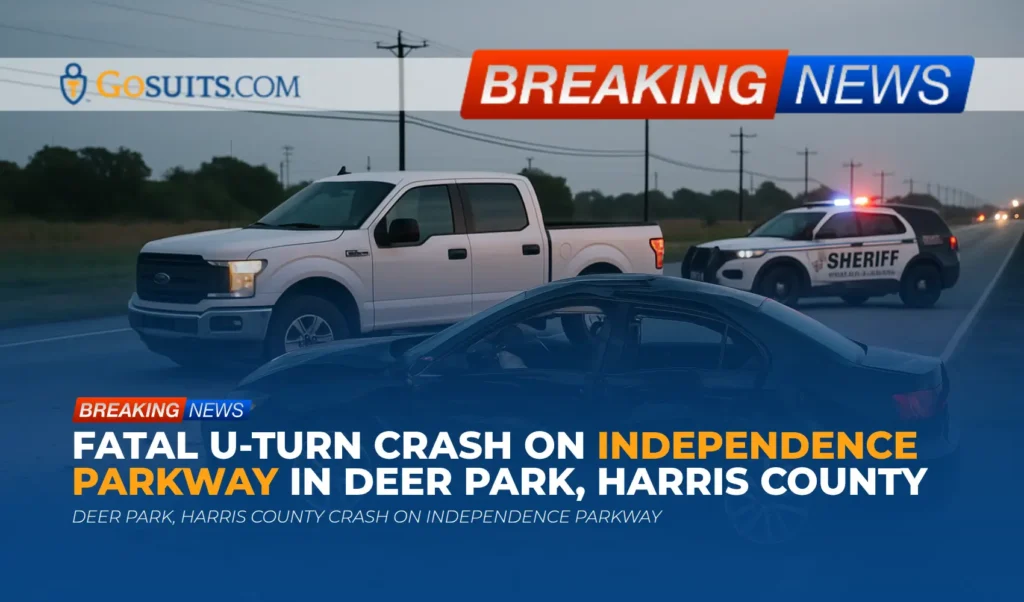- What we know about the Manhattan, Illinois bicycle and semi-truck crash
- Location context and roadway environment
- How truck and bicycle collisions happen and key safety data
- Rights of families after a fatal crash in Illinois
- Possible civil liability considerations in a truck-bicycle fatality
- What to do in the days following a fatal traffic crash in Will County
- How insurance works after a truck-bicycle fatality
- Preserving evidence and understanding the investigation process
- Supportive resources and contacts
- Commentary from Gosuits Manhattan, Illinois Personal Injury Attorney
- Time-sensitive next steps: why acting promptly matters
What we know about the Manhattan, Illinois bicycle and semi-truck crash
According to public reporting, a 13-year-old riding a bicycle was struck by a semi-truck at the intersection of State Street and East North Street in Manhattan, Illinois. The incident occurred around 5:35 p.m. on a Monday evening. Responding officers and emergency crews found the child unresponsive beneath the semi-trailer. The Will County Coroner later pronounced the child deceased at 8:13 p.m. An autopsy is pending. The crash remains under active investigation by the Manhattan Police Department and the Illinois State Police. As of the latest report, the child’s name has not been released. In a public statement, Manhattan police asked for the community’s thoughts, compassion, and prayers during this difficult time, especially for the community’s children.
These are the confirmed details available at this time. Investigators typically take days or weeks to complete their work. That process can involve scene measurements, vehicle inspections, interviews, and review of any available electronic data.
Location context and roadway environment
The collision took place at State Street and East North Street in the Village of Manhattan in Will County. While official reports have not yet described the exact traffic controls or movements at the time of impact, intersections are among the most common locations for conflicts between heavy trucks and people on bicycles. Large commercial trucks have significant blind zones alongside and behind the trailer, and wide turning radii that can create hazardous conditions for vulnerable road users if drivers do not exercise particular care.
October evening light can be variable around the 5:30 p.m. hour in northern Illinois. Visibility, sun angle, and traffic volumes may differ by day. None of these environmental details have been confirmed in the public reporting, and no conclusions can be drawn until investigators release their findings. What is certain is that young riders are among the most vulnerable users of the roadway and require heightened caution from all motorists.
How truck and bicycle collisions happen and key safety data
Although each crash is unique, research and national datasets show recurring patterns in truck and bicyclist collisions. Common mechanisms include:
- Right-turn conflicts: A truck overtakes a bicyclist traveling in the same direction, then turns right across the bicyclist’s path. Large blind zones and trailer off-tracking can contribute to this scenario.
- Left-turn conflicts at intersections: A driver turning left across oncoming traffic may fail to detect a bicyclist in the opposing lane.
- Overtaking maneuvers: Passing too closely or without adequate time and space can force a bicyclist off-line or cause direct impact.
- Dooring or merging conflicts: Opening doors or lane merges can push bicyclists into adjacent traffic lanes where trucks are present.
- Low-visibility conditions: Dusk, dawn, weather, and lighting conditions can reduce detection distance unless drivers adjust speed and scanning behavior.
Nationally, bicyclists are considered vulnerable road users because they lack the protective structure of a vehicle. The National Highway Traffic Safety Administration provides annual summaries showing hundreds of bicyclist fatalities each year across the United States, with a meaningful share occurring at intersections and in interactions with larger vehicles. See NHTSA’s bicyclist safety materials and data summaries for context on trends and risk factors here.
Public health agencies also note the profound human and economic costs of roadway deaths and injuries. The Centers for Disease Control and Prevention provides overviews on bicycle safety and injury prevention strategies, including infrastructure, speed management, and visibility measures, available from CDC.
These sources do not speak to fault in this specific Manhattan crash. They help explain why investigations focus on driver behavior, visibility, vehicle dynamics, roadway design, and compliance with traffic laws when determining what happened.
Rights of families after a fatal crash in Illinois
Illinois law provides civil remedies when a death is caused by wrongful act or negligence. Two closely related pathways are often discussed:
- Wrongful Death Act: The personal representative of the decedent’s estate may bring a claim for the benefit of surviving next of kin for their losses, which can include loss of support, companionship, and grief damages as provided by statute. See 740 ILCS 180.
- Survival Act: Certain claims the decedent would have had if they had survived can continue in the estate, including conscious pain and suffering before death and related damages. See 755 ILCS 5/27-6.
Time limits apply. In many negligence cases, Illinois allows two years from the date of death to file a wrongful death action, though there are exceptions. See 735 ILCS 5/13-202 and 740 ILCS 180/2. Claims involving public entities can have shorter timeframes, including a one-year limitation under the Local Governmental and Governmental Employees Tort Immunity Act. See 745 ILCS 10/8-101. These statutory references are provided for general information; individual circumstances vary, and deadlines can be affected by case-specific factors.
Who may recover under the Wrongful Death Act depends on family relationships and the decedent’s next of kin. The court oversees any distribution of proceeds to ensure they are allocated to those legally entitled under Illinois law.
Possible civil liability considerations in a truck-bicycle fatality
When a commercial vehicle is involved in a fatal crash, a thorough civil investigation often looks beyond the driver to understand the full chain of responsibility. Without speculating about this Manhattan crash, potential areas of inquiry generally include:
- Driver conduct: Speed, signal compliance, turning movements, right-of-way, scanning, and yielding to vulnerable road users. Illinois law imposes a duty on all drivers to exercise due care to avoid colliding with pedestrians and bicyclists. See 625 ILCS 5/11-1003.1.
- Bicycle rights on the road: Bicyclists have the same rights and duties applicable to drivers of vehicles, with some specific rules. See 625 ILCS 5/11-1502. Passing at a safe distance is required, and Illinois law specifies not less than 3 feet when overtaking a bicycle. See 625 ILCS 5/11-703.
- Company responsibility: Employer liability for a driver’s negligence within the scope of employment, hiring and training practices, monitoring of hours-of-service, and compliance with federal safety regulations. The Federal Motor Carrier Safety Administration outlines hours-of-service rules designed to reduce fatigue-related risk. See FMCSA’s summary here.
- Vehicle condition: Brakes, lighting, mirrors, underride protection, and safety equipment maintenance. Records and inspection logs may be relevant depending on the circumstances.
- Load and dispatch: How the truck was routed, time pressures, and whether any scheduling practices could have contributed to unsafe operations.
- Roadway factors: Signage, lane markings, and sightlines. Claims involving public agencies can be complex and subject to immunities and shorter claim periods under Illinois law. See 745 ILCS 10.
Because commercial carriers are required to maintain minimum levels of liability insurance, identifying the carrier and any additional insurance such as umbrella policies is a key step. FMCSA provides general information on minimum financial responsibility for interstate motor carriers here. These federal requirements are background standards; actual available coverage can be higher depending on the carrier and cargo.

What to do in the days following a fatal traffic crash in Will County
Nothing can prepare a community for the loss of a child. In the immediate days after a fatal crash, families often face urgent questions about information, paperwork, and next steps. The following general steps are intended to help organize tasks that commonly arise in Illinois after a roadway death. Every situation is different, and it is appropriate to ask trusted professionals to assist.
- Obtain the official crash report and related records: For crashes investigated by the Illinois State Police, records can be requested through the ISP’s FOIA process. See the ISP FOIA page here. For municipal police investigations, requests are typically directed to the local department’s records unit. Processing times vary, and parts of an investigative file may not be immediately available while an investigation is active.
- Request coroner and medical examiner information: In Illinois, the county coroner conducts the autopsy and determines the cause and manner of death in qualifying cases. Families can contact the county coroner’s office to ask about timelines and procedures for obtaining autopsy and toxicology results. Availability is governed by state law and local policy. Illinois’ public records law provides a framework for records requests. See the Illinois Attorney General’s FOIA guidance here.
- Obtain certified death certificates: Certified copies are often needed for insurance and estate matters. The Illinois Department of Public Health provides information on death records and how to request them here.
- Preserve personal property and evidence: Preserve the bicycle, helmet, clothing, and any devices such as lights or cameras in their post-crash condition. Photograph all items from multiple angles. Store them securely so they are available for later inspection.
- Identify witnesses and nearby video: Write down names and contact information for anyone who may have seen the collision or events just before it. Ask nearby homes or businesses if exterior cameras captured the roadway. Many systems overwrite video within days, so prompt outreach matters.
- Keep a timeline: Record dates and times of calls with agencies, medical providers, and insurers, and save all correspondence.
- Seek emotional and community support: Grief after a sudden loss is overwhelming. The Substance Abuse and Mental Health Services Administration provides guidance and connects individuals with support resources, including the 988 Suicide and Crisis Lifeline. See SAMHSA information here.
How insurance works after a truck-bicycle fatality
Multiple insurance policies may come into play after a crash involving a commercial truck. The specifics will depend on the facts of the crash, where the truck was traveling, and the driver’s employment details. Generally:
- Trucking company liability insurance: Interstate motor carriers must maintain minimum financial responsibility under federal law, which varies by cargo type. See FMCSA’s overview here. These policies typically respond to claims alleging negligence by the driver within the scope of employment.
- Excess or umbrella coverage: Many carriers maintain additional layers of coverage above primary policy limits. Identifying all layers is part of a thorough claims investigation.
- Household auto policies: In some cases, uninsured or underinsured motorist coverage on a household auto policy may be implicated, depending on policy language and circumstances.
- Cargo or shipper-related coverage: Certain operational arrangements can bring other entities and policies into focus. This is fact-specific and depends on contracts and control.
Insurance adjusters may reach out early. It is important to know that recorded statements and forms can affect later rights. Before speaking with any insurance company, consider consulting an attorney first to understand options and obligations. What is said to an insurer can be used later to limit recovery or dispute fault.
Preserving evidence and understanding the investigation process
Truck-involved crash investigations often include technical evidence that should be preserved promptly:
- Electronic logging device and driver records: ELD data, hours-of-service logs, bills of lading, and dispatch communications can show timing, rest, and route details. FMCSA explains hours-of-service rules here.
- Vehicle and trailer inspections: Brake condition, lighting, and reflective markings may be assessed. Photographs and inspection reports can be critical.
- Event data and telematics: Some tractors and fleets capture speed, brake application, GPS, and camera footage. Preservation requests sent early can help prevent overwriting or deletion.
- Scene documentation: Skid marks, debris fields, scrape marks, and resting positions can fade or be cleared within hours. Police typically measure and photograph the scene, but independent documentation can help.
Illinois law imposes duties on drivers toward bicyclists, including the general duty of due care and safe passing. See 625 ILCS 5/11-1003.1 and the overtaking statute 625 ILCS 5/11-703. Bicyclists have rights and duties similar to drivers, with certain specific rules, as outlined in 625 ILCS 5/11-1502. Investigators generally consider these and other provisions when evaluating movements, right-of-way, and safe operation. This summary is for context only and does not determine fault in any particular case.
Supportive resources and contacts
Below are public sources and agencies that commonly assist after a fatal roadway crash in Illinois. Availability of records can depend on the status of an investigation and statutory rules.
- Illinois State Police
- Crash investigations and records for incidents handled by ISP. FOIA portal and instructions are available at the ISP website here.
- ISP geographic districts handle specific counties. Manhattan is in Will County, which is within ISP District 5. District contact information and location details are available through ISP’s site here.
- Local Police Department
- For municipal investigations, contact the local department’s records unit to ask about crash reports, 911 audio, and any available body-worn or dash camera footage. Some records may be withheld while an investigation is open, consistent with Illinois law.
- County Coroner’s Office
- The county coroner conducts the autopsy and determines cause and manner of death where required. Families can ask about how to request autopsy and toxicology reports and typical timeframes. Procedures vary by county.
- Illinois Department of Public Health
- Certified death certificates and general information on death records are available through IDPH Vital Records. See IDPH’s death records page here.
- Illinois Attorney General
- Guidance on the Illinois Freedom of Information Act, which governs access to public records, including law enforcement and coroner materials where applicable, is available here.
- Crash and safety data
- NHTSA bicyclist safety topics and national data summaries are available here.
- Illinois Department of Transportation compiles statewide crash data for planning and safety. See IDOT safety and crash information here.
- Mental health and grief support
- SAMHSA provides information on the 988 Suicide and Crisis Lifeline and coping resources. Learn more here.

Commentary from Gosuits Manhattan, Illinois Personal Injury Attorney
Our hearts go out to the family, classmates, and neighbors grieving this loss in Manhattan. A child’s death on our roads is devastating, and words feel inadequate. This article is offered for general information to help the community understand what typically happens after a serious crash and what records and rights may be available under Illinois law.
Based on the facts reported so far, investigators from the Manhattan Police Department and the Illinois State Police are examining a collision between a bicyclist and a semi-truck at a local intersection. In crashes involving large commercial vehicles and vulnerable road users, the law places responsibility on drivers to use due care, scan carefully, yield when required, and pass bicycles at a safe distance. Companies that put trucks on the road also have duties related to hiring, training, and safe operations. A careful, fact-based investigation is essential to determine what happened in this specific case.
From working with families after serious crashes, we have seen how insurance carriers and large corporations can move quickly to protect their own interests. Adjusters may seek recorded statements before all facts are known. Important electronic data, like onboard camera footage and logs, can be overwritten. Without guidance, people can be pushed into signing forms or accepting interpretations of the crash that later prove incomplete. Knowing what to ask for, how to preserve evidence, and how to evaluate insurance coverage can make a meaningful difference.
Initial conversations with insurance companies carry risk. Statements can be used to limit recovery or to argue fault before investigators finish their work. A free consultation with a seasoned attorney can help clarify rights, timelines, and the steps needed to preserve and gather evidence, so families can make informed choices about the road ahead.
Time-sensitive next steps: why acting promptly matters
- Send preservation notices right away: Ask that all relevant evidence be preserved, including truck dash and inward-facing camera footage, ELD and dispatch logs, GPS data, and vehicle inspection records. Many fleets overwrite video within days. Early written notice helps reduce the risk of critical data being lost.
- Secure independent documentation: Photograph the bicycle, any safety equipment, and any visible injuries or property damage. Capture the intersection from multiple vantage points at the same time of day. This can complement police documentation and help later experts understand visibility and traffic patterns.
- Organize records: Keep a folder with agency case numbers, contact names, and dates. Save copies of any correspondence. Tracking requests to police, the coroner, and IDPH will simplify follow-up.
- Be cautious with insurers: Before contacting any insurance company or giving a recorded statement, consult an attorney to understand rights and potential consequences. What is said can be used to dispute fault, minimize losses, or close the claim prematurely.
- Calendar legal timelines: Note potential civil deadlines, including the general two-year period for wrongful death actions and shorter periods for claims involving public entities. Identifying all potentially responsible parties takes time, so starting sooner helps ensure no deadline is missed.
- Consider professional support: Complex cases involving commercial carriers often require accident reconstruction, fleet safety analysis, and careful insurance review. Getting qualified help early can improve the accuracy and completeness of the fact-gathering process.
Prompt action preserves options. As agencies complete their investigations and release records, having early documentation and preservation in place reduces uncertainty and helps ensure that the full picture of what happened can be developed with care and accuracy.






